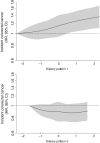Associations between Dietary Patterns and Incident Colorectal Cancer in 114,443 Individuals from the UK Biobank: A Prospective Cohort Study
- PMID: 39158415
- PMCID: PMC11528196
- DOI: 10.1158/1055-9965.EPI-24-0048
Associations between Dietary Patterns and Incident Colorectal Cancer in 114,443 Individuals from the UK Biobank: A Prospective Cohort Study
Abstract
Background: Diet-disease association studies increasingly use dietary patterns (DP) to account for the complexity of the exposure. We assessed if a DP associated with type 2 diabetes mellitus, cardiovascular disease, and all-cause mortality is also associated with colorectal cancer.
Methods: We used reduced rank regression on 24-hour recall data to identify DPs, explaining the maximum variation in four nutrient-response variables: energy density, saturated fatty acids, free sugars, and fiber density. Cox proportional hazards models examined prospective associations between DP adherence (coded in a continuous scale as z-scores as well as in quintiles) and incident colorectal cancer. Subgroup analyses were conducted for tumor site, age, and sex.
Results: After exclusions, 1,089 colorectal cancer cases occurred in 114,443 participants over a median follow-up of 8.0 years. DP1 was characterized by increased intake of chocolate and confectionery; butter; low-fiber bread; red and processed meats; and alcohol, as well as low intake of fruits, vegetables, and high-fiber cereals. After accounting for confounders, including body mass, there were positive linear associations between DP1 and incident overall colorectal cancer (HR of quintile 5 vs. 1, 1.34; 95% confidence interval, 1.16-1.53, Ptrend = 0.005) and rectal cancer (HR of quintile 5 vs. 1, 1.58; 95% confidence interval, 1.27-1.96, Ptrend = 0.009) but not for proximal or distal colon cancers. No DP2-colorectal cancer association was observed.
Conclusions: A DP previously associated with cardiometabolic disease is also associated with incident colorectal cancer, especially rectal cancers.
Impact: These consistent associations of particular food groups with both cardiometabolic disease and this diet-related cancer strengthen the evidence base for holistic population dietary guidelines to prevent ill-health.
©2024 The Authors; Published by the American Association for Cancer Research.
Conflict of interest statement
D.A. Koutoukidis reports nonfinancial support from Nestle Health Science and Oviva outside the submitted work. No disclosures were reported by the other authors.
Figures





References
-
- Siegel RL, Wagle NS, Cercek A, Smith RA, Jemal A. Colorectal cancer statistics, 2023. CA Cancer J Clin 2023;73:233–54. - PubMed
-
- Gupta S, Bhattacharya D, Acharya AN, Majumdar S, Ranjan P, Das S. Colorectal carcinoma in young adults: a retrospective study on Indian patients: 2000–2008. Colorectal Dis 2010;12:e182–9. - PubMed
-
- World Health Organization . Global cancer observatory. [Internet]. [cited 2023 May 25]. Available from:https://gco.iarc.fr/.
-
- Arnold M, Sierra MS, Laversanne M, Soerjomataram I, Jemal A, Bray F. Global patterns and trends in colorectal cancer incidence and mortality. Gut 2017;66:683–91. - PubMed
MeSH terms
Grants and funding
LinkOut - more resources
Full Text Sources
Medical

